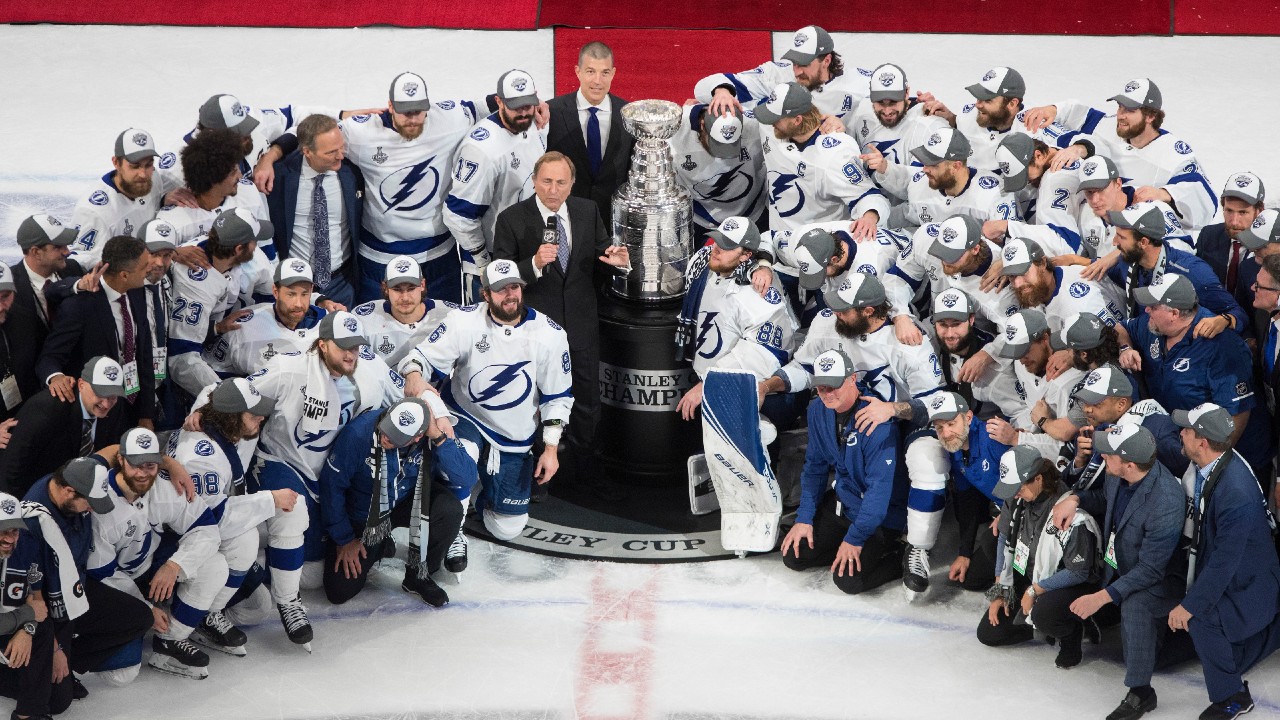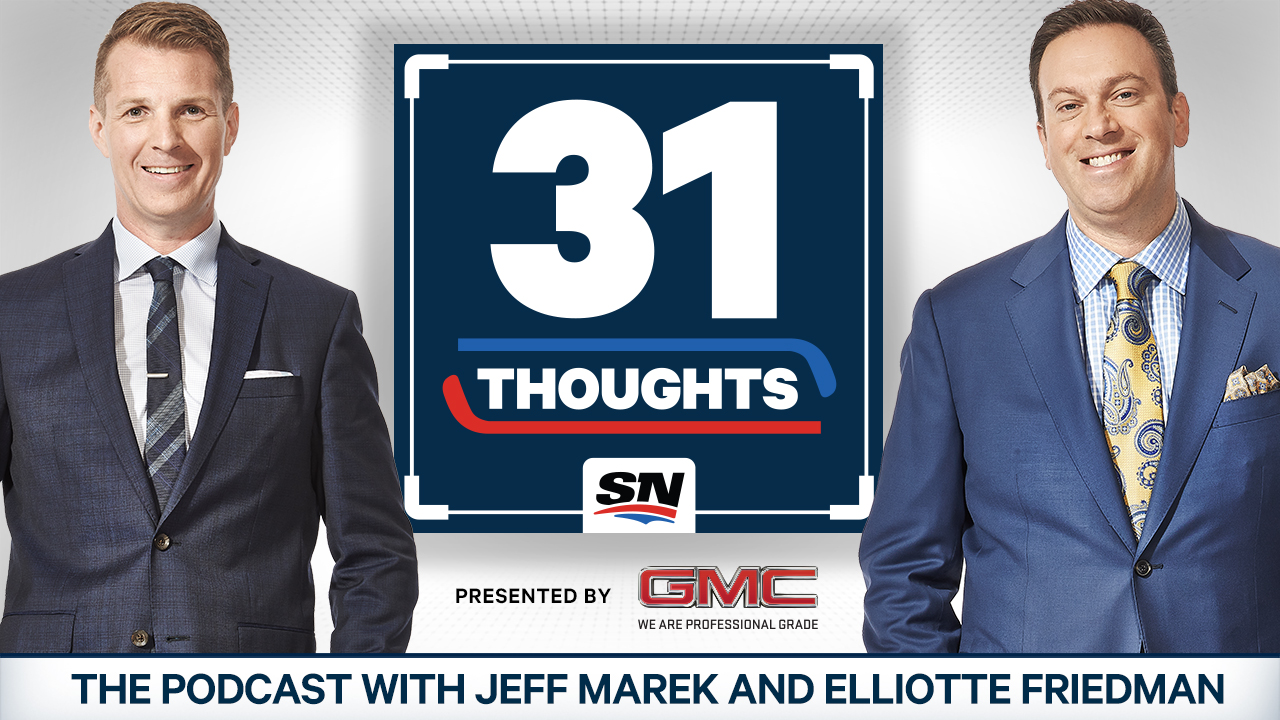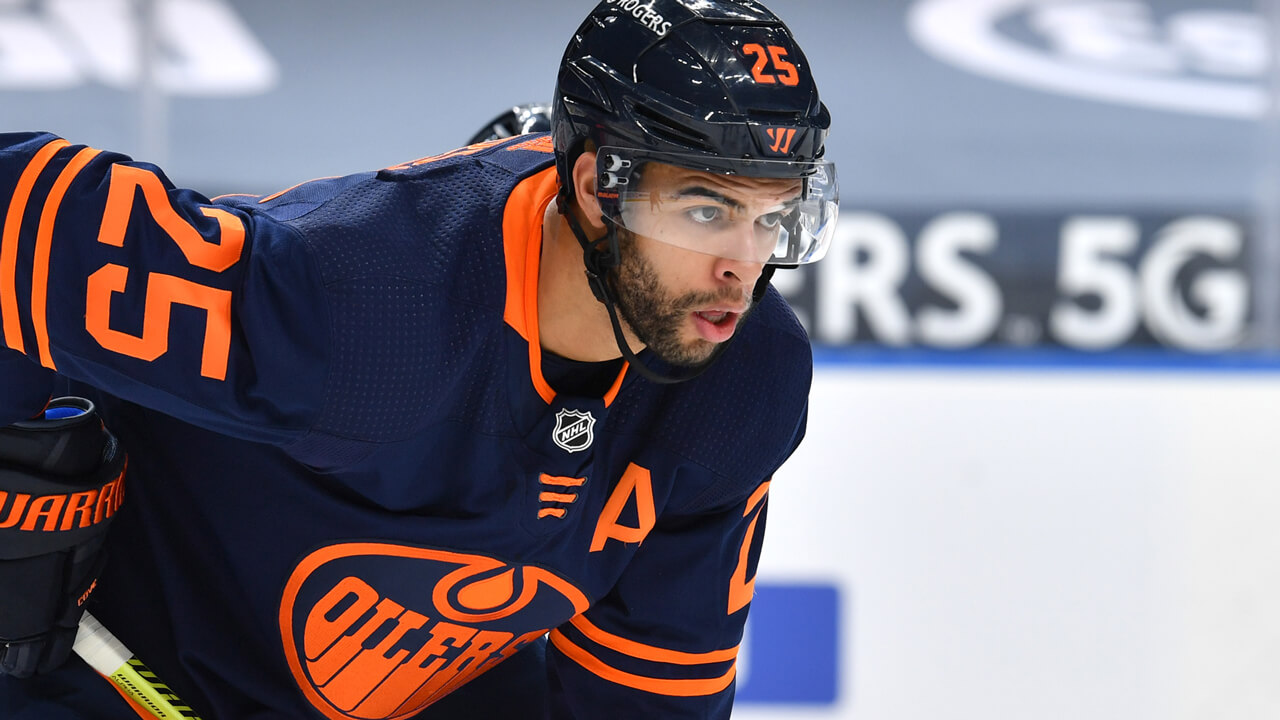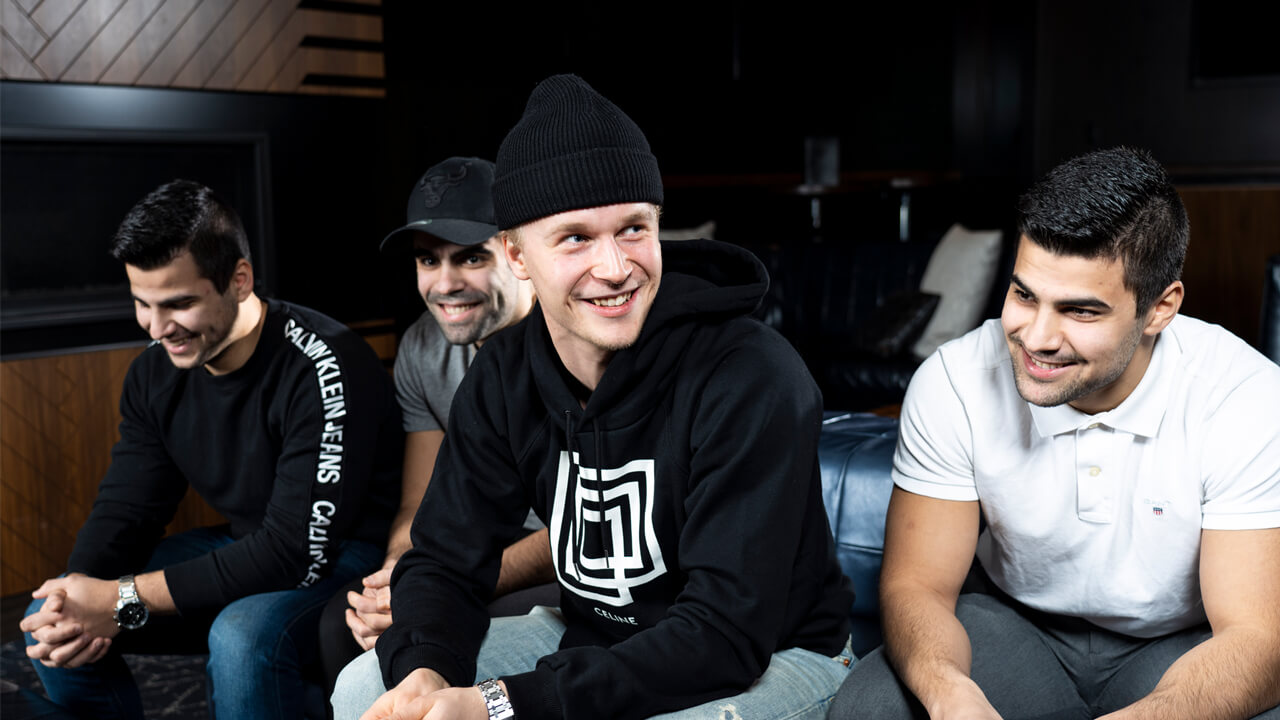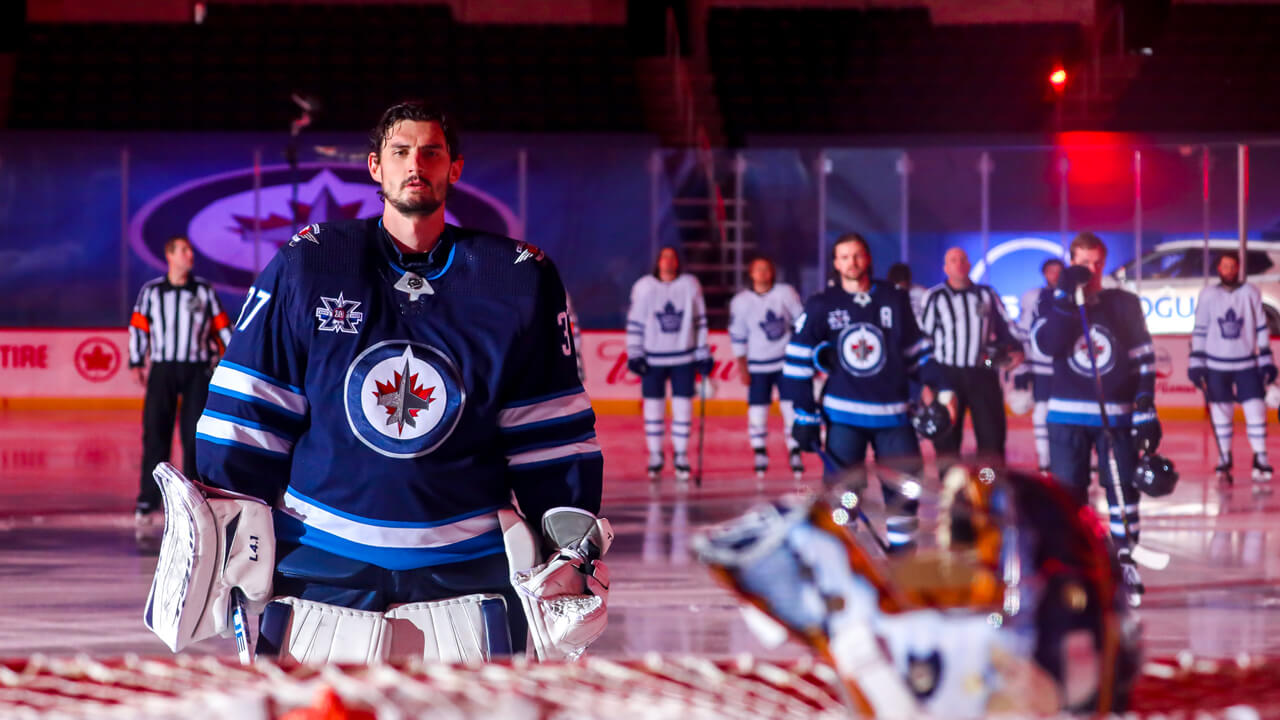The monitors in the security room provide their only views of the maelstrom on the street. There’s a fire blazing outside the store, engulfing a tree on the sidewalk. “Burn the f—er down — that’s what I like to see,” says a young man standing in front of the flames. A mob is gathered near the entrance and several people take turns trying to shatter what’s supposed to be break-proof glass. Anything and everything is used in the effort — skateboards, a shopping cart acting as a battery ram, even a few drop kicks. After two hours of repeated blows, the glass finally gives, evoking roaring cheers.
Inside the security room of the London Drugs at the intersection of Granville and Georgia in downtown Vancouver, about 20 employees are huddled by the monitors. Dubbed internally as the “safe room,” this space is also supposed to be impenetrable, but that means little at the moment. The staff is terrified. Some will later say they feared for their lives. With the front windows broken, over 300 people have flooded the two-level store. Who knows what they’re capable of doing?
The mob rushes through the aisles like a wave, stuffing cellphones, DVDs, laptops, cosmetics and food into pockets and bags, and destroying the fixtures that house expensive products. Nikon DSLR cameras are snatched up as easily as apples are plucked from a tree. One looter seizes a 50-inch Panasonic plasma TV that was on display, but running with such a large item is awkward. As he drops it to the ground, the screen is reduced to small shards on the floor.
“Can you imagine being in that kind of environment?” asks Wynne Powell, former CEO of London Drugs, recounting the horror that his employees — several of whom suffered long-term psychological issues that required therapy — endured in the safe room. “Where society fails and you see these things going on?”
This summer marks 10 years since that calamitous evening. On Wednesday, June 15, 2011, the Vancouver Canucks lost Game 7 of the Stanley Cup Final to the visiting Boston Bruins. Shortly after the buzzer sounded at the end of the third period, chaos filled the streets outside Rogers Arena. The ensuing riot created worldwide headlines and etched a dark moment in the city’s history. There was a level of destruction typically reserved for the movies. However, there was also some valour befitting a Hollywood script.
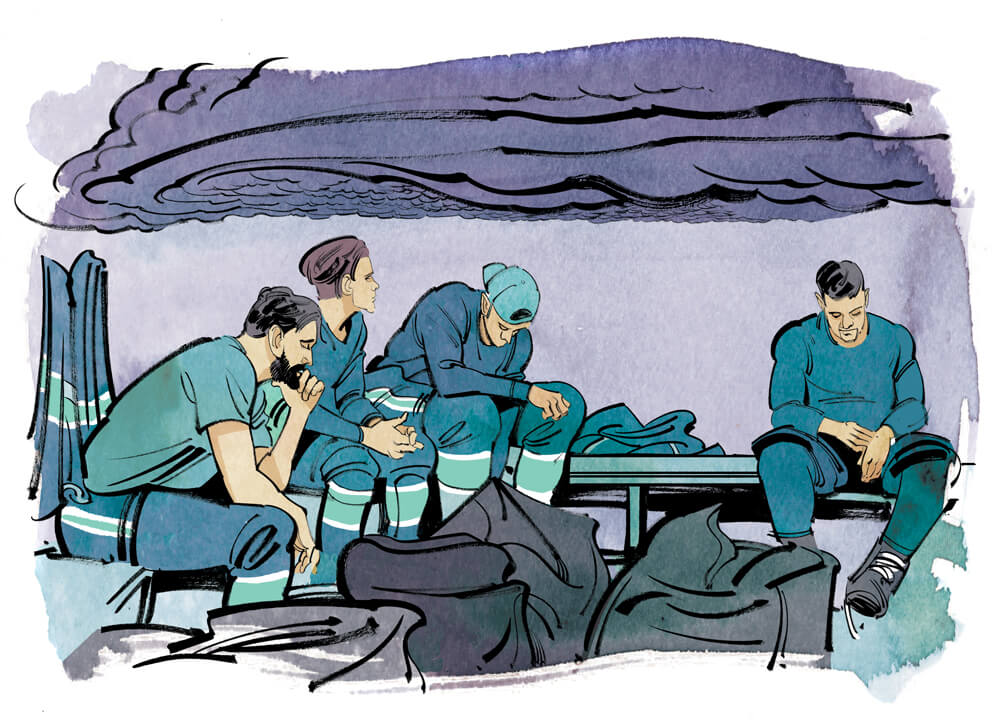
Before anarchy took over the streets, there was hostility on the ice. The back-and-forth 2011 Stanley Cup Final was physical, intense and emotionally charged, with each team developing a real distaste for the other despite having no pre-existing rivalry. The Canucks, who were the NHL’s best club during the regular season, entered Game 6 with a chance to clinch the series, but dropped that contest and then the deciding seventh game by a combined score of 9–2. That led to a teary locker room when it was all over. Head coach Alain Vigneault and owner Francesco Aquilini addressed the team with encouraging words, but the players couldn’t help but feel the pain that comes with letting a grand opportunity slip away.
TC Carling was the Canucks VP of communications and community partnerships at the time, and his role included overseeing the media relations department. Following the game, Carling was bouncing between the locker and press rooms as he facilitated his team’s availability to reporters. The Bruins’ Stanley Cup ceremony was taking place on the ice, and Carling made sure that all televisions in the dressing room were turned off. He didn’t want any salt added to the players’ wounds.
During the team’s playoff run, Carling often found himself in the laundry room. It was quiet and offered respite from his hectic post-game responsibilities, as well as the chance to collect his thoughts and even hold private conversations with players or staff, if need be. There was a small TV in that room, and during one of his visits after Game 7 it happened to be on. That’s where Carling first caught wind of what was going on outside — news cameras showing scenes of a serious ruckus unfolding.
“It was just so upsetting to layer this on to what was happening within your own building,” Carling says. “We’ve got the most devastating loss in all of these athletes’ careers. What was happening was so disappointing for most of us. And then to see what was happening outside was even more disappointing.” He tried to grasp the gravity of the situation and immediately began work with security officials to plan an escape route for personnel.
Once Canucks players finished showering and gathering themselves in the immediate aftermath of the loss, they headed upstairs to meet their families, who were gathered in a suite on an upper level at Rogers Arena. When forward Tanner Glass exited an elevator on that floor, he noticed, through a window that overlooked the downtown core, black smoke billowing in the distance. Wow, what’s going on outside? he wondered. When Glass reached the suite, he learned what Carling and Co. had informed players and their families — a full-fledged riot had commenced.
“Rightly or not, we were focused on the chance that just passed us by and probably a little bit self-centred at the time,” Glass says. “But that was washed away pretty quickly when you realized the severity of what was happening outside. Thinking about the safety of the people and the businesses and the city that we love.”
Adds Canucks defenceman Dan Hamhuis: “Obviously, there was a lot of emotion involved for us with the loss and being so close [to winning the Stanley Cup]. And then, to see [the riot], it was just a strange, strange night. All those feelings of trying to comprehend if that was really going on outside.”
General manager Mike Gillis was in a boardroom with other team executives and their families. He recalls noticing his three kids — aged 15, 20 and 25 — seemed particularly upset and unnerved. “We were exhausted after all of the travel during the playoffs and all of the issues we went through in the playoffs. And then to see that, it was shameful,” Gillis says. “It was difficult enough to deal with having lost in that final game and all the things that we had gone through to get there and how difficult it was. And then, to just turn around and be confronted with that type of activity and that type of attitude, was very difficult to watch.
“Then suddenly you become angry about it because you’re just not even given an opportunity to evaluate what happened and deal with it with your family,” he adds. “You’re thrown in to try to deal with this stuff.”
Players and staff were asked to stay in the arena until it was safe to leave. Their recollections of exactly how long varies — some say they left by 10:00 p.m., while others remember it being much later. They were all made aware of routes that would avoid the worst of the rioting. Carling and security officials determined the best way for everyone to exit was through a loading bay, which would allow them to turn left onto Pacific Boulevard and scatter from there.
When Gillis arrived at his Vancouver home that night, there was a small group of people drinking outside, seemingly waiting for him. The crowd booed the Gillis family as they got out of their vehicle in the driveway and walked into their house. Gillis’s youngest son recalls closing the blinds in his bedroom, which faced the street, and hearing furor from the gathering.
“Vancouver had become our home, and we didn’t think that reasonable people would do those things,” says Gillis. “But we were wrong.”
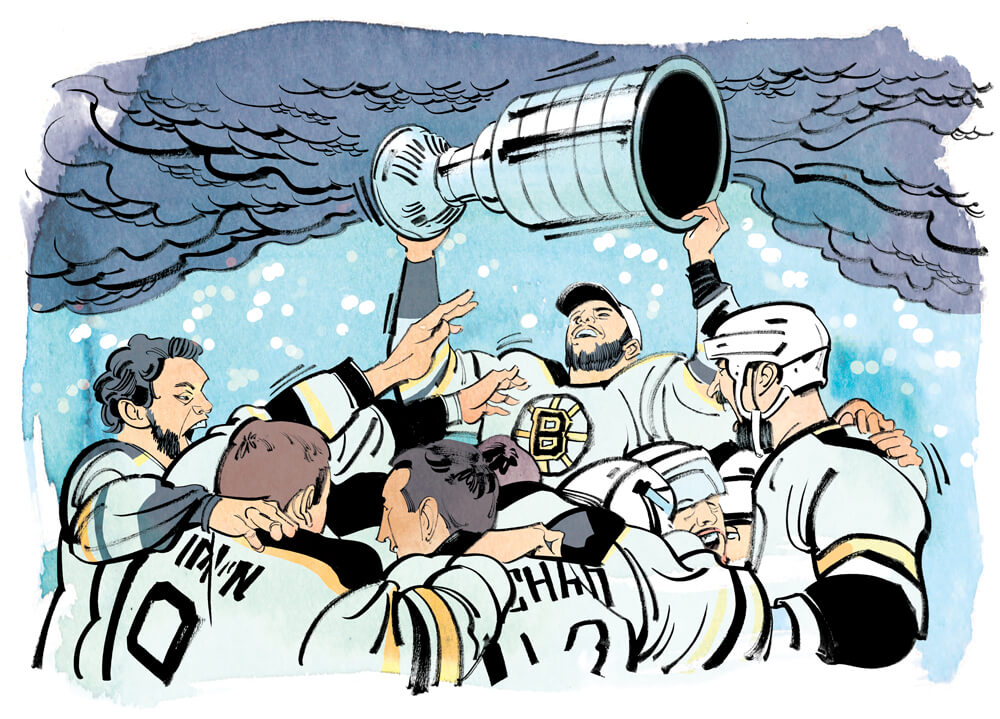
Andrew Ference had once been on the losing end of a Cup Final Game 7. The defenceman went the distance with a Calgary Flames squad that lost to the Tampa Bay Lightning in 2004 and never forgot what it felt like to have your childhood dream within reach, then taken away. Here he was, though, in Vancouver, erasing some of that pain as a member of the Boston Bruins. As he hoisted the Stanley Cup during on-ice celebrations, the thought circling his mind was that no matter what, he could now retire knowing his name was engraved on the trophy. “All of a sudden, everything you’ve been bottling up just comes to the surface,” Ference says.
The party moved from the ice to the locker room, where Bruins players revelled in joy and sips of champagne from the silver mug. This was a breakthrough for the team’s core — including Mark Recchi, Patrice Bergeron and captain Zdeno Chara — which had made the playoffs but failed to get past the second round in each of the previous three seasons. It was the franchise’s first championship since 1972, and finally allowed the Bruins to be mentioned alongside the Patriots, Celtics and Red Sox, all of whom had won rings in recent years.
Livestream every game of the Stanley Cup Playoffs, blackout-free. Plus get the NHL Draft, Free Agency, Blue Jays & MLB, NBA Playoffs matchups and more.
The rumoured plan was to have families and friends in the locker room until around 10:00 p.m., and then the players would have it to themselves for some time before catching a redeye back to Boston. That changed, though. “Somebody just mentioned, in passing, that there’s some craziness outside and that we’ve got to get going to the airport if we want the police escort,” says Ference. “It’s not like there was a whole lot of detail or we knew a whole lot of what was going on. It was just kind of like, ‘If we want the escort, we got to leave now, so wrap it up.’” Players hopped in the shower and, in short order, were on the bus headed to Vancouver International Airport.
Shawn Thornton had won a Cup with Anaheim, and remembers drinking with teammates in a parking lot tent until the California sun came up. This time was obviously different, but he stresses the riot didn’t much impact the Bruins’ celebration. “We heard that there was some rioting going on, but we were sheltered from it,” Thornton says. “We were in the locker room and then we take our bus to our plane and then we flew out, so we didn’t know the severity of it.
“Our focus at that point would have been more on accomplishing our life’s goal than what was going on in the city of Vancouver. That’s what mattered to us as a team,” he adds. “It’s awful that they rioted. Obviously not what anybody would want happening after a Stanley Cup win, no matter where you are.”
Christy Clark avoided watching hockey from arena suites, if she could. There’s just too much chatter, making it difficult to focus on the game. And with the Canucks on the brink of history, the then-premier of B.C. wanted to devote her attention entirely to the ice. She viewed the game from seats behind the Bruins’ goal with her then-10-year-old son, Hamish. Clark was wearing a Jeff Tambellini jersey — the former Canucks winger is from Port Moody, B.C., the first riding she ever represented — while her son, a goalie, donned a Roberto Luongo sweater.
Once the game finished and NHL commissioner Gary Bettman awarded the Cup to the victors, Clark stuck around to watch Bruins bruiser Milan Lucic, a Vancouver native, receive applause from the crowd. As premier — she had been sworn in just a few months earlier — Clark had an RCMP detail accompanying her. When she and Hamish walked to the car that was awaiting them in the parking lot, she was asked to get in quickly.
As they drove toward her home in the Mount Pleasant neighbourhood south of the arena, Clark noticed the officers were receiving updates in their earpieces. They couldn’t quite discern whether what was unfolding was a riot or protest, but were careful of repeating anything out loud, so as to not alarm Hamish. “I was watchful and worried,” Clark says. “It’s one of those moments where you don’t know what direction something could go in.”
When she arrived home and put Hamish to bed — he had school the next day — Clark was glued to her TV and phone as she received reports from her office and the Office of the Attorney General. “I am thinking about how we, how the province, could help,” she says. “When you’re in the heat of it, you’ve got to unleash the professionals to get it under control, really, before there’s a meaningful role the government can take. It’s like when there’s a big fire going, politicians really shouldn’t be involved in it at that point. But we should certainly be making sure firefighters are available to get in there and do their job.”
The storm quickly took shape while Clark watched. And she recalls the exact moment lightning struck: It was when the first car went up in flames. This happened in front of the post office on Georgia Street, next to the Queen Elizabeth Theatre and across from the CBC building. The area featured a plaza that was a major, open public space, Clark describes. “I was unprepared to see that car lit on fire,” she says. “In Vancouver, that’s an unbelievable, unheard-of event. Outside of my role as a premier, just as a citizen, I sat back and thought, What? In Vancouver? How could this be happening in Vancouver?”
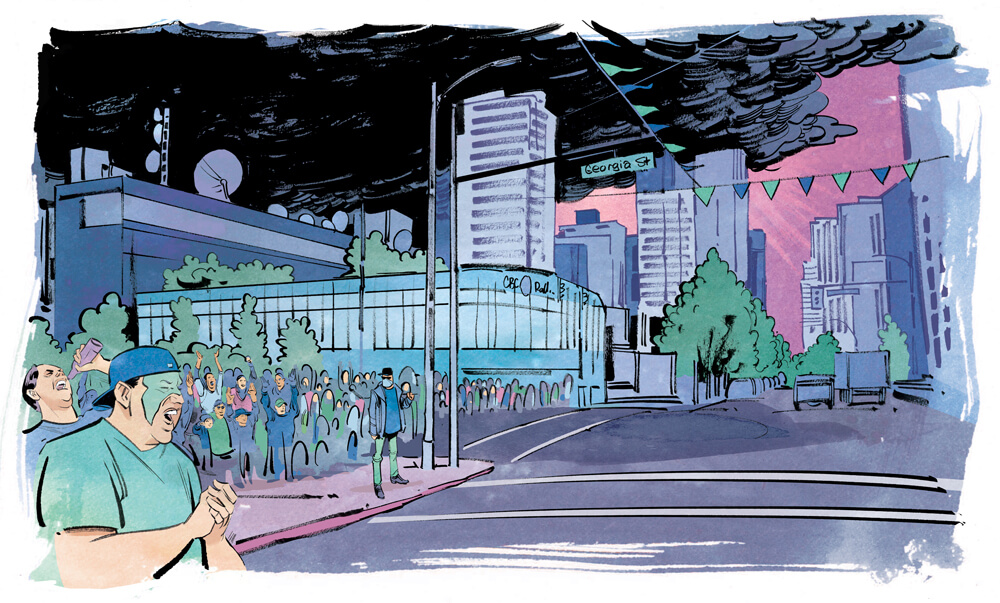
The roller-coaster Cup Final took an emotional toll on more than just the players. For Canucks fans, there was optimism at the outset that was further emboldened when their team built a 2–0 series lead. However, by the time the club dropped Game 6 in Boston, the energy of the fanbase had shifted. Charmaine de Silva, a CKNW news reporter at the time, remembers sensing that change in the lead-up to the do-or-die finale. The overall tone of callers to her radio station veered toward negative.
“It was beyond that feeling of, ‘Hey, I don’t think we’re going to win the Stanley Cup,’” says de Silva. “It just didn’t feel good, and earlier in the day, even before the game started, we had reporters from our newsroom out on the streets, and they were overhearing kids and groups of people saying, ‘Can’t wait to riot tonight,’ like it was a bit of a joke. So, there was some commentary. People even saying on air that they were hearing that, too.”
Of course, there was historical precedent for hockey being at the root of a riot in the city. When the Canucks lost Game 7 of the 1994 Final to the New York Rangers, tumult broke out on the streets of Vancouver. And while that was nearly two decades prior, it was part of the city’s history and hadn’t faded from its collective consciousness.
As the Bruins took control with a 3–0 lead near the end of the second period, reporters sent word back to the newsroom that people gathered in viewing areas were growing restless and despondent. There were reports of garbage cans being kicked and some people jumping onto a car and screaming, but nothing that yet resembled the complete lawlessness to come.
At that point, de Silva was part of an additional group sent out in the field to investigate. Her partner had brought their eight-year-old son downtown to take in the festivities. When de Silva met with them on Georgia Street, she figured they should probably head home while she carried on with her work, just to be safe. As she continued into the fray — and contributed to CKNW’s award-winning coverage — de Silva noticed the rowdiness was ratcheting up. Then, she came across a car fire. “I think everybody knew, ‘Okay, this has taken a turn for the worse,’” she says.
While calling in a live radio hit on Georgia Street, between Seymour and Richards, she spotted people smashing the windows of random stores and looting. The type of establishment didn’t seem to matter — a group even broke into a Black & Lee and pillaged tuxedos. She found herself amidst a large crowd so dense its movement swept people in like a current. It carried her in front of The Bay on Granville and Georgia — across from London Drugs. She needed to deliver another hit to the station. It was loud and for a brief moment, de Silva bent over as she held her Blackberry to her ear, trying to block out noise while she went on air. Suddenly, she was yanked from behind. She thought someone was trying to attack her.
“I didn’t know if I’m being pulled by some part of the mob, stranger, what’s happening,” says de Silva. “I look up and I see a videographer who works for a competing station. He’s got his one hand on his camera and the other hand he had used to yank me…. There was a large wooden display right by the window and they were toppling it over. So, this other journalist basically saw that I had my back to a dangerous situation and he yanked me away. And just after he yanked me away is when the display case fell. It would have fallen on me.”
Robert MacKay noticed the fracas in front of The Bay and ran over to investigate. He had watched Game 7 with his girlfriend, Tammy, at the Astoria Hotel on East Hastings Street, and, because the weather was pleasant, they had decided to walk home. MacKay saw a man standing in front of the department store facing down what seemed like hundreds of people. He was yelling, “This is my city,” and imploring the crowd to calm down and not inflict further damage. MacKay heard the man’s plea, and something about it resonated. His adrenalin was pumping, adding to the alcohol already in his system. So he joined the stranger in front of the mob, their backs up against the store. “You see what people are doing and then you just get more and more angry with the destruction,” MacKay says. “I just wanted to do my part rather than try to contribute to the madness. Trying to do something to help prevent it.”
Somebody lunged at MacKay with a metal pole. He wrestled control of it away from the attacker and then pointed it toward the crowd. His goal was to use it to push people away from the windows; his mistake was exposing his back. MacKay was quickly surrounded and pushed to the ground, where he was kicked, punched and hit with pepper spray. The aerosol served to disperse the crowd, leaving MacKay to gather himself as he dealt with the intense burning sensation in his eyes and on his face.
He couldn’t see, but soon felt two young men carrying him down the block, away from everything. Bystanders realized he was writhing in pain and offered him water bottles to pour over his head. He reached a policeman and because MacKay couldn’t see, he asked the officer to reach into his pocket, unlock his phone, and call Tammy. About 30 minutes later, he was reunited with his girlfriend. As the effects of the pepper spray began to wear off, they decided to head home on foot. MacKay’s body was extremely sore, especially his ribs, and he sported a large bump on the back of his head. However, he wasn’t seriously injured and opted against going to the hospital. “I felt like I took some good shots,” he says.
Jeff Marek and Elliotte Friedman talk to a lot of people around the hockey world, and then they tell listeners all about what they’ve heard and what they think about it.
Rich Lam, a freelance photographer who had shot Game 7 for Getty Images that night before heading out on the streets, had a strategy to avoid such injury. He’d honed it shooting protests at the 1997 APEC summit at the University of British Columbia and then in the “Battle of Seattle” World Trade Organization protests in 1999. Lam knew he had to get close to the action to snap good pictures, but in order to avoid harm during the unfolding riot in Vancouver, his personal rule was to never stand still and make himself a target to either police or the angry crowd. (A colleague was punched in the face that night in Vancouver and almost had their equipment stolen, he says.)
“I call it, ‘Don’t be a tourist,’” Lam says. “Head on a swivel, always looking, observing potential pictures and potential hazards, and always thinking, Once you’re done taking those pictures, where are you going next? And at a certain point, figuring out what your escape route is.”
The streets of Vancouver provided ample opportunity for compelling photos that night. At one point, Lam observed mounted police assemble in a line while, in front of them, officers on foot, equipped with batons and shields, pushed the crowd back a few hundred metres. It’s a visual Lam equates to the Running of the Bulls in Spain. “If you don’t move, they’re coming right over top of you,” he says.
After one of those pushes down Seymour Street, when there was a momentary pause as police regrouped, Lam spotted two people lying in the middle of the road. One of them appeared to be in distress. Lam thought they might be victims of police brutality. From a photographic perspective, he figured the shot looked interesting with an injured person juxtaposed against cops holding batons in the background. After he snapped it, Lam quickly glanced at the screen on the back of his camera to see if it was in focus and then, staying true to his rule, kept moving.
When he eventually returned to Rogers Arena and handed his memory card to an editor, Lam learned the truth behind the photo, which ended up being his most memorable work from the evening. It turned out the moment he’d captured wasn’t one person helping an injured rioter on the ground — it was a couple kissing. The photograph went viral and garnered attention from across the globe — a morning show from Australia even reached out to Lam for an interview. It later won a National Newspaper Award.
“I was packing up my camera when someone said, ‘Hey, nice pictures of the kissing couple.’ And in my mind, I don’t remember that anyone was kissing in that whole thing,” recalls Lam. “And so, I went back to the editing room just to make sure and clear anything up. Sure enough, they had it big on the screen and it was just like, ‘Okay, there are two people kissing there.’ It didn’t really cross my mind much, though. It’d been a long day. The talk of the room was, ‘Hey, nice picture.’ I’m thinking, Where are we going to go eat?”
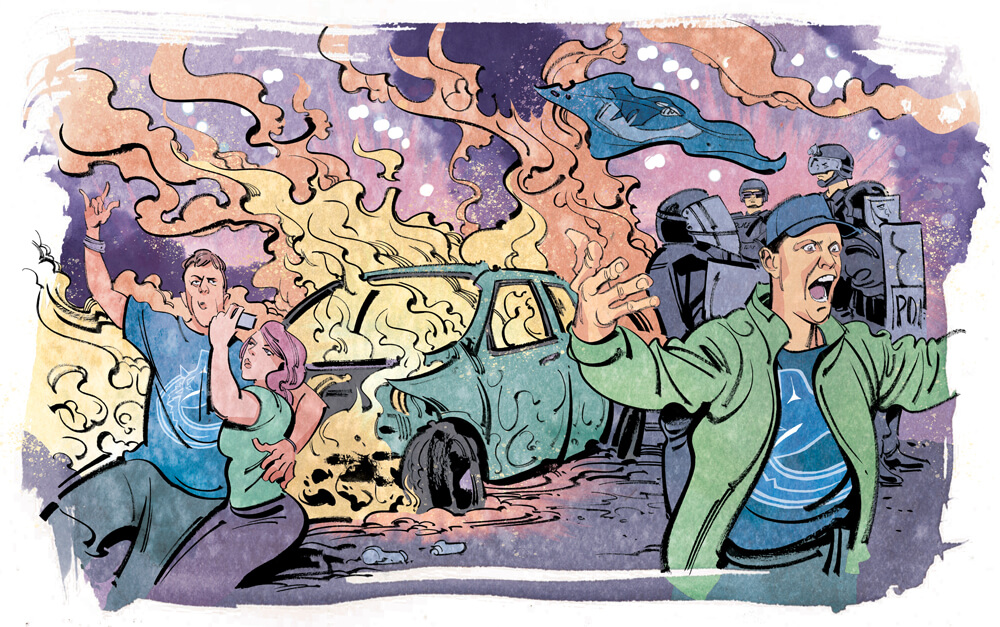
St Paul’s Hospital, located about 1.5 kilometres from ground zero, saw the brunt of traffic that night. A code orange was called, which is reserved for disasters, such as massive fires, earthquakes or airplane crashes. A station was set up outside the hospital with six large, green garbage pails filled with water for people exposed to tear gas to wash their eyes and faces. There was concern that bringing them inside the building would essentially gas the emergency ward. The smell of the spray was thick in the air, despite the distance between the hospital and where it was deployed. Dr. Eric Grafstein, head of the St. Paul’s emergency department at the time, recalls an acrid taste in his mouth after spending just a few minutes outside.
The hospital treated 114 people from the riot that night, he says, noting that a significant portion had consumed alcohol. Around 50 people had injuries — mostly soft tissue or head injuries — and of that lot, only three required admission, a figure less than the hospital’s normal daily rate. One man had broken ribs and a collapsed lung, but he was well enough to go home in the morning. “We thought we were going to be overwhelmed,” Grafstein says. “But in truth, there was a busy spike for about four or five hours, and then it kind of died down.”
Grafstein went home around 2:00 a.m., once the department stabilized. He could still hear some sirens off in the distance when he left the hospital, and, looking back now, says the night had surreal qualities.
“It was certainly one of the most unique experiences,” says Grafstein. “Unique, because it basically was, from a medical perspective, very positive…. Lots of people came in to help. We had to turn physicians away. Cardiologists called and said, ‘Can I come and help?’ And we would say, ‘No.’”
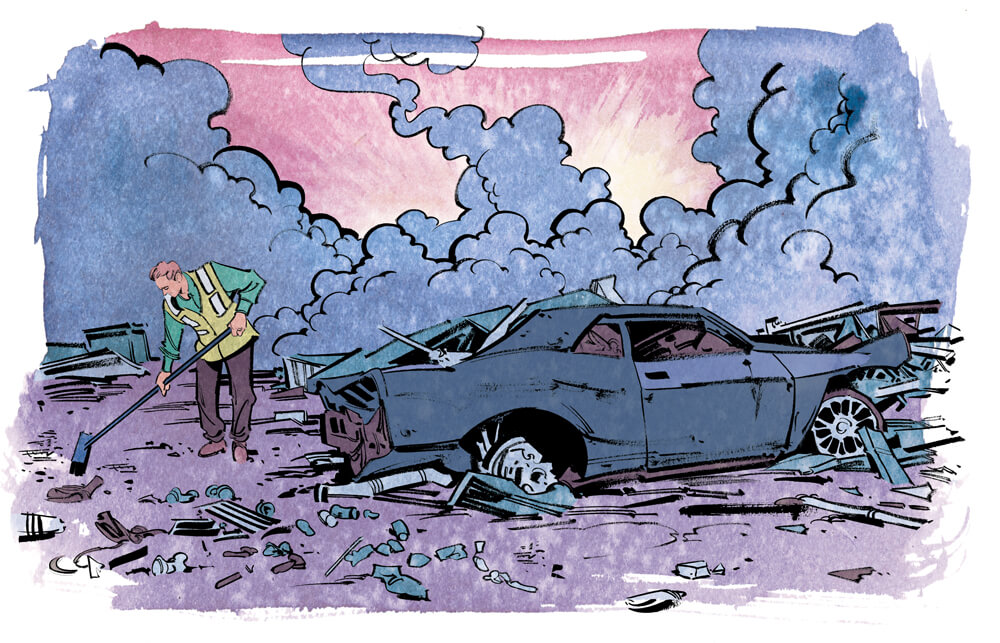
The final numbers are staggering. The chaos lasted five hours. In that time, rioters damaged or destroyed 112 businesses and 122 vehicles, according to a 2016 report by the B.C. government. Businesses suffered losses estimated at $2.7 million, and civilians lost an additional $540,000. The report also pinpointed 52 assaults against police, emergency personnel and civilians.
There were considerable efforts to prosecute those who participated in the riot, in part, to set an example. B.C.’s Criminal Justice Branch laid 912 charges against 300 suspects, including 54 youths.
“The rioters turned out to be hooligans who would later say, ‘I got caught up in the moment,’” Jim Chu, former Vancouver Police Department chief, says in an email. “We posted pictures on websites and printed wanted posters. While there was a mix of backgrounds, including some with criminal records, our investigators noticed that many rioters were identified by former schoolteachers.
“There were also otherwise good people, not criminals, who just got caught up in the insanity and were a perfect example of the contagion effect that can occur — it is a psychological phenomenon that police study and try to develop proactive strategies to address.”
Aquilini, the Canucks owner, and captain Henrik Sedin visited Chu and frontline officers at VPD headquarters soon after the Cup Final to show support. The club won the Presidents’ Trophy again the following season (before suffering a first-round loss to the Los Angeles Kings) and in the lead up to the 2012 playoffs, launched a PSA campaign on how to celebrate responsibly with the tagline, This Is Our Home.
“If I’m being honest, I think I live in the nicest city I’ve ever been to in the most beautiful province,” says Carling, the former Canucks communications staffer. “I don’t think [the riot] left any long-term [stain]. The key will be next time. It just can’t happen again. The fact that it happened twice is really upsetting. But it cannot happen again.”
The riot led to deep introspection across the board — police, media, politicians and fans were all left with lessons to take away. Tied into that was the overarching question of where Vancouver stood as a global city. “It was a jolting reminder that we as a city have got big-city problems,” says Christy Clark, the former B.C. premier. “With big-city status and big-city attractiveness and big-city growth, you get big-city problems.”
Charmaine de Silva, who reported on the riot and now works as news director at NEWS 1130 & CityNews Vancouver, says the city has undergone a maturation process over the past decade. Shame eventually gave way to a concerted focus on how to successfully hold large public events. In her role as co-chair of the Vancouver Pride Society, de Silva was involved in planning the Pride Festival parade for a number of years. Following the riot, she recalls it was difficult to get city approval to serve alcohol in public plazas or beer gardens. However, that shifted around four years ago.
“[It was] almost like we were grounded,” de Silva says. “And I feel like we’re getting to the point now where it’s like we’ve grown up a little bit more and we can talk about having these events. And it doesn’t feel like your parents are still mad at you.
“It’s not that I don’t think we could ever have a riot again,” de Silva continues. “But I think it was such a thoroughly embarrassing experience for people from Vancouver. A lot of these people were charged. There was public shaming. People’s lives were destroyed. So there’s a sense of embarrassment, but there was accountability…. I think there’s just a feeling that we don’t want to get there again.”

